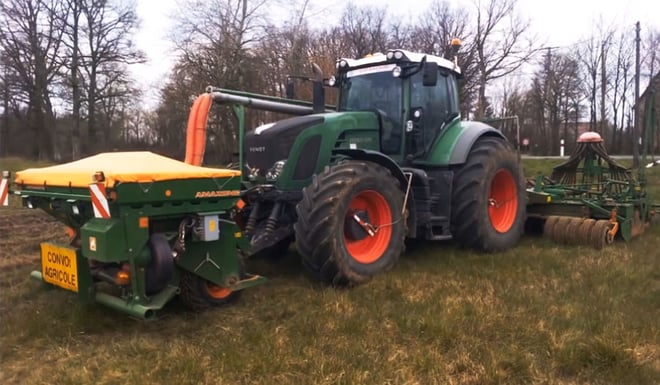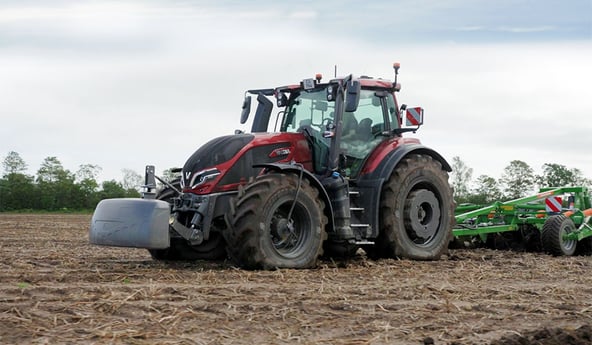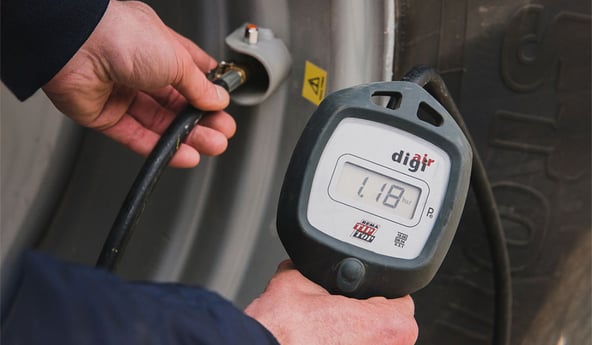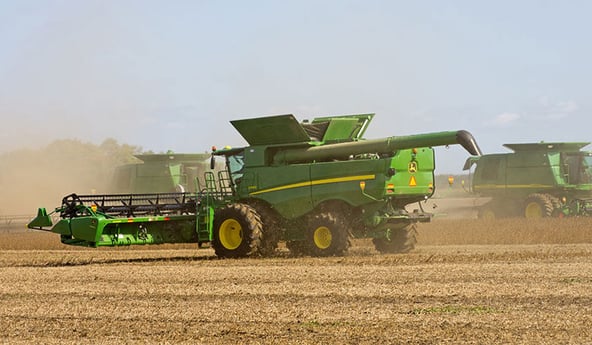It may well seem easier to choose a mid-range pressure at 1.2 bar which can be acceptable for road transport and acceptable for field work.
Choosing to compromise with this in-between solution would have terrible consequences on your profitability, although you may not be aware of it. On the road, you consume more fuel and your tyres wear out more quickly. In the fields, you spin more, the soil in your fields is compacted and your yields decrease progressively. In short, this compromise at 1.2 bar is anything but a good deal.
If you have done any research on the topic, you will probably have had a shock on discovering the price of a full CTIS. However, this option is not as costly as it may first appear.
You could start by choosing to install a simple pressure control system. This option enables you to monitor your pressure constantly and then decide to make pressure adjustments manually.
This is often the best way to gauge whether investing in a full CTIS system would make sense financially.
Both options have their advantages which could help you to make your decision. Let’s explain them:
1. The advantage of a Tyre Pressure Monitoring System (TPMS)
As you know, it is essential to adapt the pressure of your farming tyres to your use. The pressure will not remain stable over time and requires adjustment depending on several different factors such as driving speed, the load carried or the state of the soil. Instead of checking the pressure regularly, there is a simple and innovative solution: TPMS pressure sensors.
The Tyre Pressure Monitoring System is an electronic device integrated into the tractor cabin whose role is to inform the driver, in real time, when the pressure of one or more tyres is not right.
It is composed of sensors on the tyres and a simple control monitor which shows easy to interpret warning signals in the shape of pictograms or gauges.
With a TPMS, you will no longer need to check the pressure of your agricultural tyres manually, because the automatic electronic system informs you immediately of any abnormal pressure levels.
Here are 5 reasons to choose this system:
1. Easy installation
As well as the control monitor, the TPMS uses sensors which are attached directly in the place of the valve in the agricultural tyres.
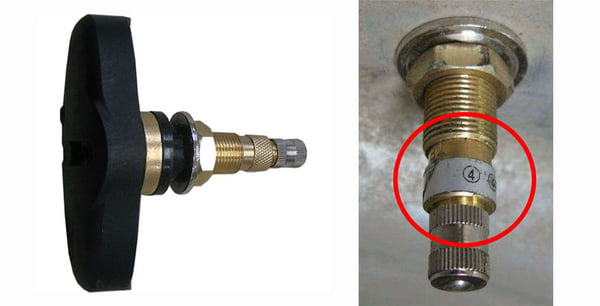 It’s important to comply with the number indicated on each sensor:
It’s important to comply with the number indicated on each sensor:
- N°1 and 2 correspond to the front tyres, from left to right.
- N°3 and 4 to the rear tyres.
How to install the sensors:
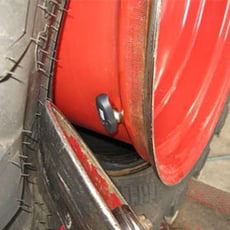
- Detach and push the sidewall and talon to the side.
- Remove the original valve.
- Place the TPMS sensors in the numerical order indicated above.
- Check that the sidewall and the heel will not damage the sensors when you reinstall the tyre on the rim.
- Tighten to between 5 and 8 Nm.
A wireless system is installed in the cabin to give you constant visibility of the pressure and temperature of your farming tyres. Available in 3 different screen colours, it is powered by the cigarette lighter.
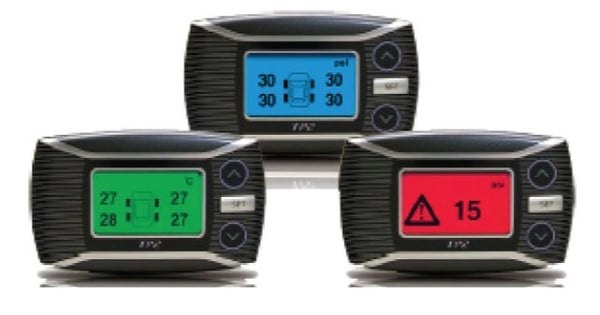
2. Immediate visibility of pressure imbalance
The TPMS system provides you with real time visibility of any pressure imbalance in one of the 4 tyres.
For road/field pressure adjustment, you can programme two pre-configured settings, to simplify your adjustment without having to change the configuration at each pressure change.
3. Increased security
The slightest of problems is indicated immediately by a warning sound and clear and visible pictograms displayed on the screen: low and high pressure, slow or sudden loss of air.
For security reasons, the alarm triggers can be adjusted according to your needs:
- Low Pressure alarm: default setting is at 20% below the reference pressure level, but you can change this setting by following the indications in the user instructions.
- High Pressure alarm: default setting is at 30% above the reference pressure level.
- Temperature alarm: triggered at 80°C.
4. Continuous monitoring of pressure
Tyre pressure can vary according to driving speed or external temperature. It’s difficult to monitor it permanently without a specifically adapted system, such as the TPMS.
Through the display panels installed in the cabin, you can easily monitor the pressure of your tyres on the road or in fields and change it quickly in case of problems.
5. Very low budget
The TPMS costs less than a full CTIS system. It’s therefore an interesting option if you just want to monitor the pressure of your agricultural tyres.
What’s more, adjusting the pressure when changing from field to road use will allow you to:
- Reduce fuel consumption
- Increase the traction of your combination vehicle
- Reduce spinning
- Prevent your tyres from overheating and wearing out quickly
The cost savings resulting from all these points will be far superior to the cost of purchasing a TPMS.
2. The advantage of a full CTIS (Central Tyre Inflation System)
Like the TPMS, the CTIS is a device installed directly on the agricultural tyres, but with a few differences. As its name suggests, it allows you to adjust the tyre pressure during use, directly from the cabin. The operator has a control panel (OCP) to check and configure the pressure without leaving the tractor cabin.
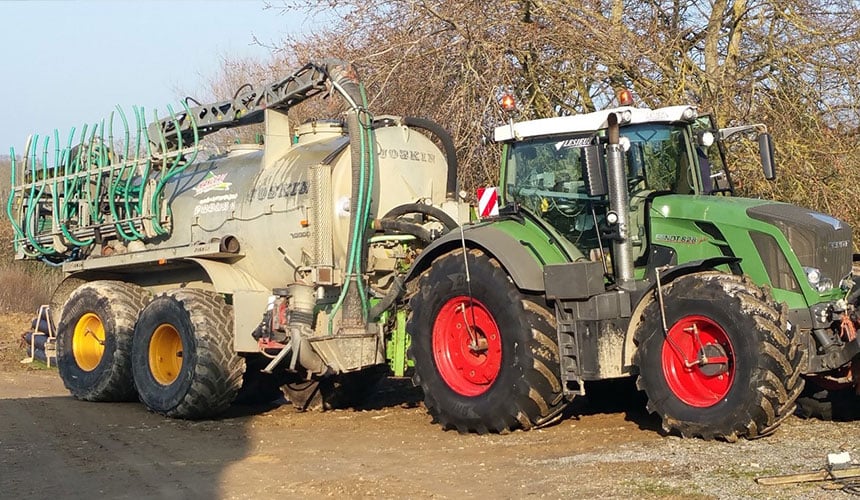
As well as the OCP, the CTIS is composed of the following elements:
- Rotary joints: they distribute the air between the rotating wheel and the fixed axle.
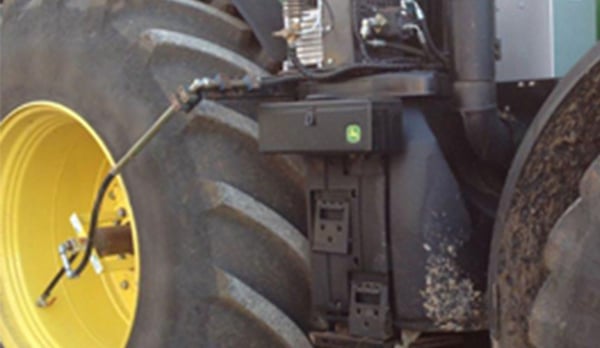
- A compressor: the key element of the device, it sometimes exists in tractors equipped with air braking, but needs to be installed on machines without compressed air generators.
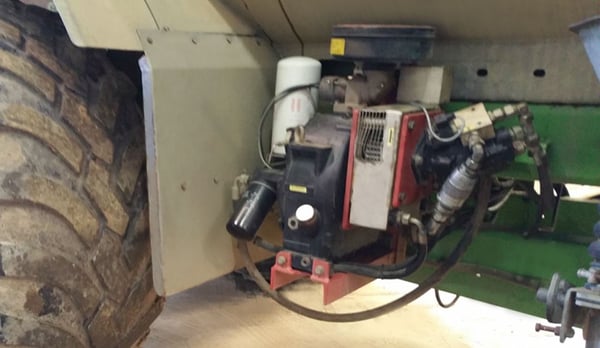
- A monitor: installed in the cabin, indicates information and warning signals in real time in case of excess pressure or loss of pressure, as well as overheating.
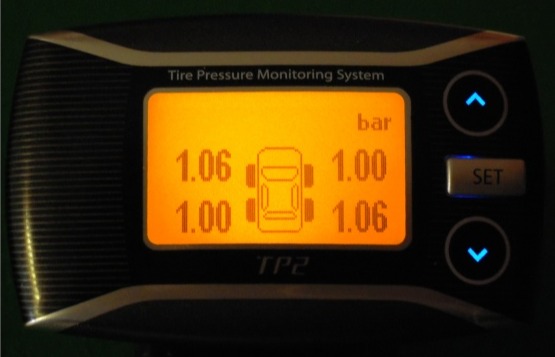
The central tyre inflation system is an innovative solution which comes with many advantages:
1. Immediate adjustment of pressure
While it is advisable to use low pressure for working in the fields, as it will reduce spinning and soil compaction while improving driver comfort, it is better to use a higher pressure for road use. This will reduce rolling resistance, premature wear to the tyres and fuel consumption.
For mixed use, on both roads and fields, installing a CTIS is a great way of adjusting the tyre pressure immediately while continuing to drive.
2. Substantial time saving
With the CTIS, tyre pressure is adjusted in just a few minutes without leaving the cabin.
For more elaborate models, you can drive and manage the tyre pressure at the same time, when changing from road to field surfaces. Your tyre pressure will increase on the road and will be reduced when entering a field.
3. Savings on fuel
Driving with the most suitable tyre pressure will reduce your fuel consumption, whatever the type of surface, the load or the type of activity.
- On the road: inflating up to 2 bars reduces rolling resistance, which will save you up to 30% in fuel.
- In the fields: a low pressure at 0.8 bar reduces spinning, which also reduces fuel consumption.
4. Protection of soil and optimisation of yield
By enabling the driver to adjust the tyre pressure for each type of use or surface, the CTIS helps to protect the soil and improves the tractive force of the agricultural tyres.
Overall, the soil will be easier to work as the risk of compaction is minimised due to the reduced pressure on arrival in the fields.
The root system of crops is protected, for an increased agricultural yield.
5. Reduction of wear to tyres
The CTIS is the best option for achieving optimal pressure in the fields and on the road, thus limiting premature wear to your tyres.
The risk of spinning is reduced in the fields, while the contact with the ground is minimised on the road.
Whatever the context, driving with your tyres at the right pressure facilitates the traction of your machinery and increases the lifespan of your farming tyres. You won’t need to replace them as often.
6. Increased comfort and safety
Finally, among the advantages of the CTIS, is the essential element of the driver’s comfort and safety.
- On the road: the higher pressure enables you to drive safely, as it stabilises your trajectory and improves your vehicle’s breaking capacity.
- In the fields: low tyre pressure reduces vibrations, lessening tiredness and back pains and their impacts on your health.
The bridgestone-agriculture.eu blog is written and administered by tractor tyre experts who can provide you with advice dto help you optimise your productivity (Technical data for agricultural tyres - Agricultural tyre performance - Pressure advice for agricultural tyres - Soil compaction solutions - Sprayer tyre pressure - etc.)
To take it a step further and increase the profitability of your farm, the tractor tyre Experts has prepared a free highly detailed ebook which explains the essential role of agricultural tyres on your productivity.
Most people who read this article have also read some of the following articles:
- 12 tips to better manage the pressure of your agricultural tyres
- No, adjusting the pressure of your tractor tyres is not optional
- How can I be sure that my agricultural tyres are always at the right pressure?
- Non-adjusted tyre pressure will lead to damage to my tyres
- Pressure: it’s the volume of air in the tractor tyre that counts
- 7 advantages of low-pressure tyres compared to normal tyres
This information is intended only to make you aware of the technical and functional aspects of agricultural tires and their use. It does not allow you to make a judgment or a definitive conclusion on a given problem. Only your agricultural tire expert is able to make a technical assessment and take a final decision, case by case.
Leave a
commentary
Your email address will not be published.
Required fields are indicated with *


